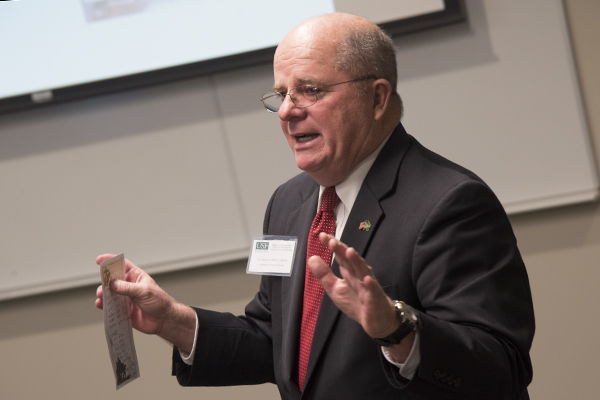Experts in rehabilitation and neuromusculoskeletal sciences from Florida’s universities gathered for the Inaugural Summit of the USF Center for Neuromusculoskeletal Research, held January 16, 2015 at CAMLS in downtown Tampa, FL.
Hosted by the USF School of Physical Therapy & Rehabilitation Sciences, the day-long Summit set out to identify and discuss priorities for rehabilitation sciences research and address the burden of neuromusculoskeletal disease on Florida’s population. In addition to USF, the scientists attending represented faculty from Florida A&M University, Florida Gulf Coast University, National University of Health Sciences. Nova Southeastern University, Palmer College of Chiropractic, and University of North Florida.
Musculoskeletal conditions, which can include arthritis, lupus, fibromyalgia, osteoporosis, adult and pediatric injuries, spinal pain and disabilities, and brain and spinal cord injuries, are among the most disabling and costly conditions affecting Americans, said. William S. Quillen, PT, DPT, PhD, FACSM, associate dean and director of the USF School of Physical Therapy and Rehabilitation Sciences.
“One thing that will surely stop economic growth is neuromusculoskeletal injuries,” Dr. Quillen told the group.
“The burden of cost for these conditions is felt throughout the health care system – both in-patient and out-patient, and long-term services – and causing loss of productivity and a huge negative impact on quality of life.”
“Well-designed and impactful research is needed to combat the negative effects of neuromusculoskeletal conditions throughout the State of Florida, United States, and the world,” said John M. Mayer, DC, PhD, Lincoln Endowed Chair and Associate Professor the USF School of Physical Therapy & Rehabilitation Sciences.
The event featured remarks by Lt. Gen. Martin Steele, (U.S. Marine Corps retired), who urged the group to reach beyond the boundaries of their own universities to collaborate with each other and to keep patients in mind as they build their research.
“First, I thank you for what you do and for your commitment to the quality of life for Americans and the people around the world,” said Lt. Gen. Steele, who came to USF five years ago as associate vice president for Veterans Research and chairs the Veterans Reintegration Program and executive director of USF Military Partnerships.
“This is a great effort here, focuses on collaboration, not competition. This is the first summit, and you will be the plank holders. This moment, this opportunity, is a window we have to jump through.”
Lt. Gen. Steele pointed out that USF is affiliated with the James A. Haley VA Hospital, the busiest VA hospital in the country, and the Bill Young VA Hospital, providing ample opportunities for strong collaboration. And as more and more veterans return home, he said, the number of injuries will need to be addressed.
“It is critical what you’re doing, even at the cellular level, because it’s only getting worse. The sustained injuries, the load-bearing equipment they wear, the helmets and neck injuries, the pelvic stress. Low back pain is the biggest issue we have in the military today, particularly in the Marines and the Army. And the demands for what they need to carry are only getting higher.”
And he urged them to continue with their work for all “soldiers, airmen and women, Marines, coast Guard and anyone else who is injured to give them all a chance, an opportunity, to live their lives larger than they’re living them right now.”
Following Lt. Gen. Steele’s keynote address, the group set out to create an asset map of research already taking place and facilities available around the state, which will provide a baseline of the current state of neuromusculoskeletal research initiatives, collaborations, and priorities in Florida.
Dr. Quillen provided a launching point for discussion.
“We were fortunate to acquire of the past few years about a million-dollars-worth of equipment that can quantifiably measure every part of the neuromuscular functional performance,” Dr. Quillen said. “So why can’t our work be inter-institutional. It’s collaboration, not competition.”
Photos by Eric Younghans, USF Health Office of Communications.



